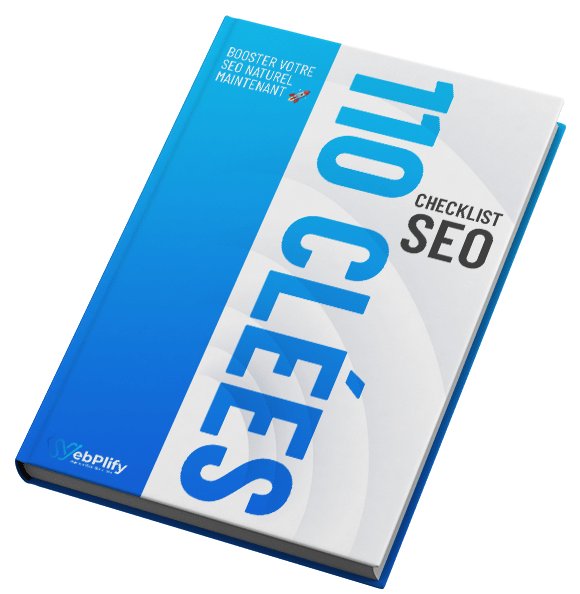Table of contents
Toggle✅ To sum up: 5 e-commerce SEO tips to implement now
Optimize your product listings
➤ Titles with keywords, unique descriptions, well-structured tags: every listing must appeal to Google and to your customers.Add schema tags (rich snippets)
➤ Display prices, reviews or availability directly in search results to increase your click-through rate.Create a blog around your products
➤ Relevant content attracts qualified traffic and positions your store as an expert in its field.Work on your local SEO (Quebec)
➤ Target your local clientele with geolocalized keywords and optimize your Google Business listing.Speed up your site’s loading speed
➤ A fast store improves the user experience, reduces bounce rates and boosts your SEO.
Running an online store without mastering e-commerce SEO is like opening a store on a deserted street. Many shop owners struggle to attract qualified traffic despite a well-stocked catalog and competitive products. This article reveals five practical tips for optimizing your SEO and turning your online store into a magnet for potential customers.
Product sheet optimization
Product data sheets are an important part of an e-commerce site’s SEO. They enable search engines to understand exactly what you’re selling, and improve your visibility to potential buyers. Proper optimization of these pages considerably increases your chances of appearing on the first page of search results. Product page optimization is an important component of an overall e-commerce SEO strategy.
To optimize your product pages effectively, several technical elements need to be worked on carefully. The first priority is to create titles rich in relevant keywords that match user queries. Descriptions must be unique and detailed for each item, with a minimum of 400 words to attract Google’s attention. Use of the semantic field related to your domain reinforces relevance in the eyes of search engines.
| Element | Description | SEO Impact |
|---|---|---|
| <Title tag> | Page title, max 65 characters, primary + secondary query. | Ranking criterion, influences click-through rate (CTR). |
| Meta description | Summary of content, must encourage clicks. | Influences CTR, informs Google about content. |
| H1 title | Title visible to the user, must correspond to the query. | Indicates the page’s main subject to search engines. |
| Product description | Unique, relevant content, +400 words, rich semantic field. | Improves positioning, meets search intent. |
| URL | Product name + relevant keywords. | Facilitates indexing, improves understanding of the subject. |
Use of schema tags (rich snippets)
Schema tags are a set of HTML codes added to web pages to provide precise information to search engines. This structured data enables Google to better understand the content of a page and thus display rich snippets in search results. For an e-commerce site, rich snippets are an effective lever for improving online visibility, as they directly display information such as price, availability and product reviews.
The main way to implement these tags on an e-commerce site is via the JSON-LD format, recommended by Google for its ease of integration. This technique significantly increases user click-through rates, thanks to the presence of visually appealing information in search results. Implementing schema tags is an important step, but don’t forget the 6 steps to optimizing your SEO in 2024.
| Tag type | Description |
|---|---|
| Product | Detailed information on a product (name, description, price, availability). |
| Offer | Offer details (price, currency, stock status). |
| Review | Customer reviews and ratings. |
| AggregateRating | Overall product rating based on several reviews. |
These are the types of schema tags that are essential for e-commerce.
- Product Snippets: Display key product information.
- Review Snippets: Present customer reviews and ratings.
- Special Offers: Highlight promotions and discounts.
These tags help search engines understand your content.
Creating blog content for e-commerce
A blog integrated into an online store is a major asset for improving Google visibility and natural search engine optimization. This strategic component creates a content hub that attracts the attention of search engines while establishing your brand’s expertise in your industry. Blog posts offer added value to visitors by addressing relevant topics related to your products.
Regular publication of quality content generates additional organic traffic to your e-commerce site. To maximize your blog’s effectiveness, opt for a structured editorial calendar that maintains regularity in the distribution of articles. Optimizing images with descriptive ALT tags also contributes to the SEO of your pages and reinforces user engagement with your content.
Here are some ideas for successful blog topics for Quebec e-commerce.
- Customer success stories: Share successful projects.
- Behind the scenes: Show your company behind the scenes.
- Services/Products: Present your offers creatively.
These ideas can generate traffic and engagement.
Sharing your achievements with customers is a concrete way of demonstrating the quality of your products and services. This approach strengthens your credibility with potential customers and enriches your site’s content with terms relevant to your field of activity. By tagging your customers in these publications, you increase the chances of them being shared, thereby expanding your audience on the Quebec web.
To adapt your blog to the specifics of the local market, choose a niche that you’re passionate about and can write about on a regular basis. Clearly define your visual identity and adopt a writing style that represents your personality while remaining accessible to the Quebec audience. Avoid expressions that are too regional or references that your target audience might not understand, to maximize the impact of your content on search engines.
Local search optimization (Quebec)
Local search optimization is very important for Quebec-based e-tailers wishing to stand out in an increasingly competitive market. Local SEO involves adapting your SEO strategy to effectively target customers in your specific geographic area. Search engines pay particular attention to queries with local intent, which represents a significant opportunity for online stores in Quebec.
To improve your visibility with Quebec customers, several specific techniques are particularly effective. Optimizing your Google My Business profile is an important first step, with complete, up-to-date information. Targeting local keywords, including terms specifically used in Quebec, helps attract qualified traffic. Creating relevant content mentioning Quebec locations, events or cultural references also strengthens your local positioning.
| Aspect | Quebec | France |
|---|---|---|
| Language | Québécois French (local expressions) | Standard French |
| Keywords | Specific terms used in Quebec | General terms |
| Culture | Quebec cultural references | French cultural references |
This table perfectly illustrates the linguistic and cultural differences to be taken into account when optimizing an e-commerce site for the Quebec market. Local expressions, often influenced by North American English, differ considerably from the standard French used in France. For example, Quebecers use terms like “magasinage” instead of “shopping”, or “stationnement” rather than “parking”. These linguistic peculiarities need to be integrated into your content strategy to maximize your local visibility.
Given these specificities, local expertise becomes essential to develop SEO strategies that are truly adapted to the Quebec market. SEO agencies in Quebec possess this specialized knowledge of local search behavior and can help you implement a customized strategy that effectively targets your local audience. This tailored approach will not only improve your rankings and conversion rates.
Improved site loading speed
Loading speed has been an important factor in search engine rankings since 2010 on desktop and since 2018 on mobile. Google favors fast pages over slower ones in order to offer a better user experience. A site that’s too slow also risks having fewer pages crawled by indexing robots, which allocate a limited amount of time to each site. The bounce rate rises considerably when pages are slow to display, sending negative signals to the algorithms.
Loading speed has a direct influence on your online store’s conversion rates. When visitors have to wait excessively to access your content, they are more likely to leave your site and turn to your competitors. This can seriously compromise yourSEO and brand perception. Even before designing your conversion strategy, it’s vital to improve this fundamental technical criterion to keep your potential customers’ attention.
There are a number of particularly effective techniques for speeding up an e-commerce site. Choosing the right hosting is the first important step: a shared server may be suitable for moderate traffic, but a high-traffic site will require a dedicated server. Image compression considerably reduces page weight without sacrificing visual quality. The use of a content delivery network (CDN) ensures local distribution of files and improves display speed. File compression and resource caching also help optimize performance. To find out more about the importance of a high-performance technical architecture, read this FrenchWeb article.
Need to BOOST your online store? Give us a call.
Comparison
Implementing an effective SEO strategy for your online store means prioritizing your actions according to your business objectives and available resources. Each technique has its own advantages, depending on the context. Product listing optimization is the foundation of e-commerce SEO, with a direct impact on conversion rates. Schema tags, on the other hand, offer increased visibility in search results thanks to rich snippets that catch users’ eye. Blog content represents a medium-term strategy for establishing your expertise and attracting qualified traffic, while local SEO enables you to effectively target Quebec customers with terms specific to their market. When it comes to loading speed, this simultaneously influences both the user experience and the ranking signals sent to search engines.
| SEO tips | Benefits | Difficulties |
|---|---|---|
| Product sheet optimization | Increases visibility, attracts qualified traffic, improves conversion. | Requires time and effort, unique content essential. |
| Schema tags | Improves display results, increases CTR. | Technical implementation required. |
| Blog content | Attracts traffic, establishes expertise, creates internal links. | Requires regularity, relevant content. |
| Local SEO (Quebec) | Target local customers, increase regional visibility. | Knowledge of Quebec market required. |
| Loading speed | Improves user experience and ranking. | Complex technical optimization. |
This comparison table highlights the specifics of each SEO technique for your e-commerce site. For start-up online stores with limited resources, priority should be given to optimizing product sheets and improving loading speed. These two elements form the basis of a satisfactory user experience and good SEO. For established sites looking to stand out from the competition, implementing schema tags represents an excellent investment with a rapid return on click-through rates. Blog content is particularly effective for specialist stores wishing to establish their authority in a particular field. As for local SEO, it becomes essential for Quebec-based e-tailers targeting a local clientele or seeking to differentiate themselves in a French-speaking North American market. Need to BOOST your online store? Just give us a call.
Applying these five SEO tips will turn your online store into a magnet for qualified customers. By optimizing your product sheets, making judicious use of schema tags and creating relevant blog content, you’ll gain visibility in the search engines. While your competitors are neglecting these technical aspects, your e-commerce site is already attracting visitors ready to buy.
Frequently asked questions about e-commerce SEO (FAQ)
How much does SEO for e-commerce cost?
The cost of an e-commerce SEO service in Quebec generally ranges from $500 to $3,500 CAD per month. Rates vary according to site size and complexity, industry sector, local visibility objectives and services included.
SEO is a long-term investment that offers lasting profitability by attracting consistent organic traffic. Although it can take time to produce concrete results, it is essential for a lasting online presence.
What tools are essential for e-commerce SEO?
For e-commerce SEO, several tools are essential, including analysis, keyword research, site auditing and ranking tracking. All-in-one tools include Ahrefs and Semrush, while Google Search Console is essential for SEO analysis.
Other tools, such as SE Ranking and Sitechecker, enable performance monitoring and error correction. The choice of tools depends on the specific needs of each e-commerce site and its SEO objectives.
How do I choose the right keywords for my e-commerce business?
To choose the right keywords for your e-commerce business, start with keyword research to identify the best terms for your website. A keyword is a word or phrase that describes your product page or web page.
There are short and long tail keywords. Put yourself in your customers’ shoes and use keyword suggestion tools like Google Suggest or Ubersuggest to complete your list and optimize your site’s SEO.
What are the disadvantages of SEO for an online store?
The disadvantages of SEO for an online store include the time and patience required to achieve results, as well as dependence on search engines. SEO is a long-term strategy that requires time to optimize content and build quality links.
What’s more, increased competition in the SEO field demands effective strategies to stand out from the crowd. It is therefore essential to adopt effective strategies to stand out from the crowd, notably by creating quality, relevant content.
How to measure the ROI (Return on Investment) of an e-commerce SEO strategy?
SEO ROI measures the profitability of an SEO strategy and is calculated monthly, quarterly or annually using the formula: (Revenue – Expenses) / Expenses * 100. Steps include determining the number of new customers brought in by SEO via Google Analytics.
The next step is to calculate the Customer Lifetime Value (CLV), the SEO investment (tools, freelancers, time spent) and finally the SEO ROI. It’s advisable to wait at least six months before measuring SEO ROI.















